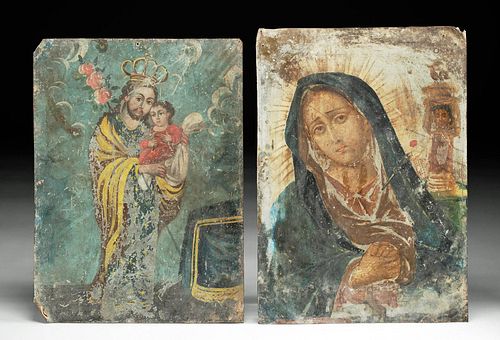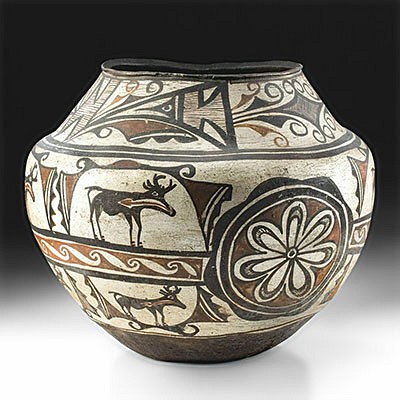Pair of 19th C. Mexican Retablos - Mary & St. Joseph
Lot 125a
About Seller
Artemis Fine Arts
686 S Taylor Ave, Ste 106
Louisville, CO 80027
United States
Selling antiquities, ancient and ethnographic art online since 1993, Artemis Gallery specializes in Classical Antiquities (Egyptian, Greek, Roman, Near Eastern), Asian, Pre-Columbian, African / Tribal / Oceanographic art. Our extensive inventory includes pottery, stone, metal, wood, glass and textil...Read more
Categories
Estimate:
$600 - $900
Absentee vs Live bid
Two ways to bid:
- Leave a max absentee bid and the platform will bid on your behalf up to your maximum bid during the live auction.
- Bid live during the auction and your bids will be submitted real-time to the auctioneer.
Bid Increments
| Price | Bid Increment |
|---|---|
| $0 | $25 |
| $300 | $50 |
| $1,000 | $100 |
| $2,000 | $250 |
| $5,000 | $500 |
| $10,000 | $1,000 |
| $20,000 | $2,500 |
| $50,000 | $5,000 |
| $100,000 | $10,000 |
| $200,000 | $20,000 |
About Auction
By Artemis Fine Arts
Nov 18, 2021
Set Reminder
2021-11-18 10:00:00
2021-11-18 10:00:00
America/New_York
Bidsquare
Bidsquare : Art & Artifacts of North America
https://www.bidsquare.com/auctions/artemis-gallery/art-artifacts-of-north-america-7894
Join us for a special auction not to be missed! Collectible Native American art from antiquity to mid-20th century, Spanish Colonial, Latin American, Pre-Columbian, fine & folk art, American frontier items, fossils, and much more! Artemis Fine Arts info@artemisfinearts.com
Join us for a special auction not to be missed! Collectible Native American art from antiquity to mid-20th century, Spanish Colonial, Latin American, Pre-Columbian, fine & folk art, American frontier items, fossils, and much more! Artemis Fine Arts info@artemisfinearts.com
- Lot Description
Latin America, Mexico, ca. late 19th century CE. A finely painted pair of retablos on heavy gauge tin representing the earthly parents of Jesus: one of St. Joseph holding the Christ child and the other of the Virgin Mary as Our Lady of Sorrows. The first depicts a crowned St. Joseph (San Jose) standing in flowing vestments of blue, maroon, and yellow with a sizeable openwork diadem, as he tenderly cradles the infant Jesu in his left arm and holds a staff of pink lilies in his right arm. Adorned with coral-hued draperies, the Christ Child grasps a petite wooden Cross - an allusion to his fate and representation of his Christian dominion - in his left hand as he affectionately rests his head on the left cheek of his earthly father. Alternatively, he second stunning retablo depicts the Virgin Mary as Our Lady of Sorrows - Mater Dolorosa in Latin. Wearing a traditional blue veil over a mauve-hued robe, the Blessed Virgin is shown experiencing one of the 7 Great Sorrows: the crucifixion of the Christ. Size of largest (Our Lady of Sorrows): 10" W x 14" H (25.4 cm x 35.6 cm)
She holds her hands together in prayer as she tilts her head to her right, contemplating Christ's crucifixion with a serene gaze surrounded by radiating light that represents a halo. Behind the Virgin is a column with the visage of Christ topped by a rooster. This iconography is derived from Early Christian art in which the rooster is frequently associated with St. Peter in the scene in which Christ announces that his disciple will deny him three times before the cock crows. As is customary for Mater Dolorosa imagery, a sword pierces the Virgin Mary's heart, a reference to Luke 2:35: "And Simeon blessed them and said to Mary His mother, 'Behold, this Child is appointed for the fall and rise of many in Israel, and for a sign to be opposed - and a sword will pierce even your own soul - to the end that thoughts from many hearts may be revealed.'"
The cult of Joseph originated during the time of Luther when the Catholic Church was seeking out new heroes to meet the needs of the Counter Reformation. Prior to this time, Joseph was somewhat ignored. The Carmelite Order, under the direction of Saint Theresa, rejuvenated the image of Saint Joseph. Instead of being portrayed as an elderly man who watched over Mary, he grew to be depicted as a virile man in the prime of his life, full of youth and strength, yet portrayed as a gentle man of tenderness as we see in this example.
Provenance: ex-Dr. David Harner collection, Arkansas, USA, acquired 1950s to 1960s
All items legal to buy/sell under U.S. Statute covering cultural patrimony Code 2600, CHAPTER 14, and are guaranteed to be as described or your money back.
A Certificate of Authenticity will accompany all winning bids.
PLEASE NOTE: Due to recent increases of shipments being seized by Australian & German customs (even for items with pre-UNESCO provenance), we will no longer ship most antiquities and ancient Chinese art to Australia & Germany. For categories of items that are acceptable to ship to Australia or Germany, please contact us directly or work with your local customs brokerage firm.
Display stands not described as included/custom in the item description are for photography purposes only and will not be included with the item upon shipping.
#161370Both have small areas of loss in corners, as well as warping and oxidation, as is typical with antique tin. Otherwise, both are excellent with nice remains of pigments.Condition
- Shipping Info
-
All shipping is handled in-house for your convenience. Your invoice from Artemis Gallery will include shipping calculation instructions. If in doubt, please inquire BEFORE bidding for estimated shipping costs for individual items.
-
- Buyer's Premium



 EUR
EUR CAD
CAD AUD
AUD GBP
GBP MXN
MXN HKD
HKD CNY
CNY MYR
MYR SEK
SEK SGD
SGD CHF
CHF THB
THB














